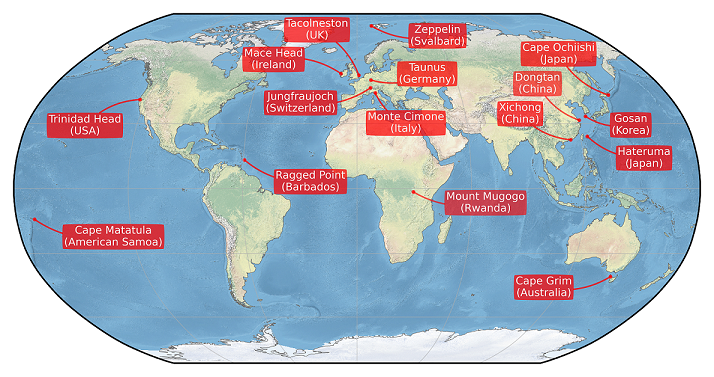
Figure: AGAGE measurement sites (2023 update)
AGAGE performs real-time, high-frequency measurements of approximately 50 trace gases at stations around the world, and interprets these measurements using three-dimensional models and inverse theory to further understanding of ozone depletion and climate change and to address verification issues arising from the Montreal (ozone) and Kyoto (climate) Protocols. AGAGE utilizes the Medusa GC-MS and GC-multi-detector instruments, and is distinguished by its capability to measure at high frequency all the important species in the Montreal Protocol and all non-CO2 gases in the Kyoto Protocol. The scientific objectives of AGAGE are important in furthering understanding of global chemical and climatic phenomena. They are:
- To determine optimally from observations the global rates of emission and/or destruction (i.e., lifetimes) of anthropogenic chlorocarbons, chlorofluorocarbons (CFCs), bromocarbons, hydrochlorofluorocarbons (HCFCs), hydrofluorocarbons (HFCs) and perfluorocarbons (PFCs) that contribute most of the reactive halogen to the stratosphere and/or are strong infrared absorbers.
- To document accurately global distributions and temporal behaviors of the biogenic/anthropogenic gases important in climate change and/or ozone depletion: methane, nitrous oxide, carbon monoxide, hydrogen, methyl chloride, and methyl bromide.
- To determine optimally the average concentrations and trends of tropospheric hydroxyl radicals from the rates of destruction of atmospheric methyl chloroform, HFCs, and HCFCs deduced from their measured mole fractions together with estimates of their emissions. III-4
- To determine optimally, from atmospheric observations and estimates of their destruction rates, the magnitudes and distributions by region of surface sources/sinks for these gases.
- To provide accurate data on the global accumulation of these trace gases, which are used to test the synoptic/regional/global-scale circulations predicted by three-dimensional models.
- To provide global and regional measurements of methane, carbon monoxide, and hydrogen that, together with estimates of hydroxyl levels, can be used to test primary atmospheric oxidation pathways at mid-latitudes and the tropics.
Professor R. Prinn (MIT) is the principal investigator for overall leadership and coordination of AGAGE, and for data processing and theoretical analysis for all AGAGE gases. Professor R. Weiss (SIO, UCSD) is the principal investigator for the experimental components of AGAGE with specific responsibility for the Cape Matatula, Samoa and Trinidad Head, CA stations and for absolute calibration at the La Jolla, CA laboratory. Dr. S. O’Doherty (University of Bristol) is the PI for the Mace Head, Ireland and Ragged Point, Barbados stations.
Mr. P. Krummel (CSIRO) is the PI for the Cape Grim, Tasmania, Australia station, the Cape Grim air archive, and inter-comparisons with other laboratories. The PI’s of the affiliated stations are as follows: Dr. S. Reimann (EMPA) is the PI for the AGAGE-affiliated station at Jungfraujoch, Switzerland.
Dr. C. Lunder is the PI for the Ny-Ålesund, Norway AGAGE-affiliated station. Dr. M. Maione (U. Urbino) is the PI for the Monte Cimone, Italy AGAGE-affiliated station. Dr. T.Saito (NIES) is the PI for the Hateruma Island, Japan and Cape Oichi-ishi, Japan AGAGE-affiliated stations. Dr. S.-Y. Park (Kyungpook Natl. Univ.) is the PI for the AGAGE-affiliated station at Gosan, S. Korea.
Dr. L. Zhou (CAMS, CMA) is the PI for the Shangdianzi, China AGAGE-affiliated station. Dr. R. Wang (GaTech) is the Global Network Scientist in charge of meteorology-related data processing and archiving, along with Drs. J. Huang and M. Rigby.
Contact information for these individuals and other Station Scientists and Global Network Scientists is available at the AGAGE website.
Updated October 2024